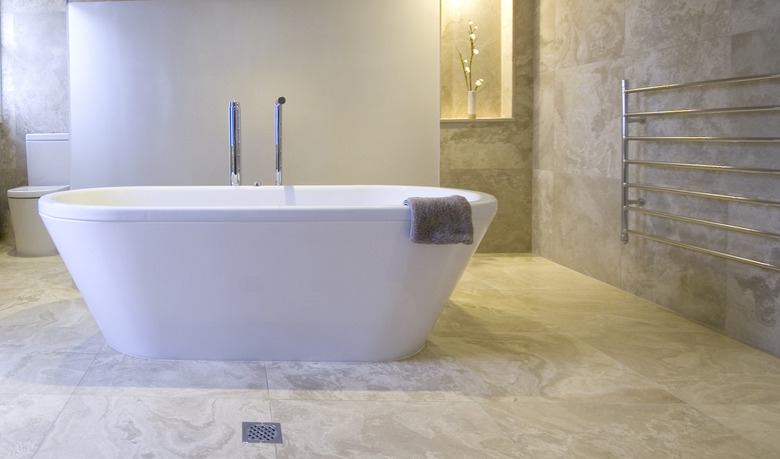Will Using Chlorine Bleach Ruin My Porcelain Bathtub?
We may receive a commission on purchases made from links.
Porcelain sinks and bathtubs look great but can become dull or stained with use over time. Since porcelain is a ceramic material, it has some specific cleaning guidelines to prevent damage. You can use chlorine bleach to clean a porcelain bathtub only if it is white. Avoid chlorine bleach for colored and vintage porcelain because it could cause damage or discoloration.
As a safety precaution when using bleach products or other chemical cleaners, always ventilate the room properly and wear gloves and protective eyewear if necessary.
Tip
Use chlorine bleach only on a white porcelain bathtub and avoid it for colored and vintage porcelain as it can harm the finish.
Start With Liquid Dish Soap
Start With Liquid Dish Soap
As a rule of thumb for porcelain, always start with the gentlest cleaning solution. Try using liquid dish soap on your first attempt. Many stains can be removed by scrubbing them with a nonabrasive sponge and warm water. Dry the sink or bathtub with a towel. If deeper stains remain, you'll have to use a stronger cleaner.
Bring in the Bleach
Bring in the Bleach
If soap and water alone don't do the trick, you may have to use bleach but with several precautions. Porcelain is a sensitive material, so avoid harsh scrubbing and chemicals if possible and, again, start with the least abrasive option.
If you have a white porcelain tub, you can use bleach to clean it. However, don't use chlorine bleach on colored or vintage porcelain as it can cause damage. Instead, try using a liquid oxygen bleach for colored porcelain. This type of product can also be used to clean white porcelain as an alternative. It's a gentler and greener substitute.
When applying bleach, put it in a spray bottle for easy application. Carefully cover the entire sink or bathtub with paper towels to create a protective layer. Spray either the bleach or oxygen bleach over the paper towels and allow it to set in for 30 to 60 minutes. Throw away the bleach-soaked paper towels. Rinse the sink or tub thoroughly with clean water to remove the bleach.
Use a Mild Abrasive
Use a Mild Abrasive
As a bleach alternative, you can clean porcelain with a mild abrasive such as Bar Keepers Friend. It contains oxalic acid, which is an effective stain fighter. Use a small amount and scrub vigorously with a nonabrasive sponge. However, it should be used sparingly because using too much or using it too frequently could cause scratches or discoloration.
Try Bleach Alternatives
Try Bleach Alternatives
If using bleach products makes you nervous and you want to avoid them, there are several natural alternatives such as lemon juice or vinegar. Both are fairly gentle but are still acidic, so be sure to thoroughly rinse them away with water when you're done cleaning. Dry the sink or bathtub off with a towel.
Modern Bathroom suggests using a small amount of lemon essential oil as a protective finish after cleaning. It will create a barrier to help prevent stains from setting. Gel Gloss is another product that can leave a protective barrier or be used as a stain remover.
Naval Jelly is excellent for removing rust marks and rings that may result from shaving cream or aerosol cans. It contains phosphoric acid as its effective ingredient. Apply a light coat on the rust stain. Since Naval Jelly is most commonly used to remove rust from metal, use caution when cleaning a porcelain surface. Watch the stain and when you see the rust change color, you know it's working and it's time to rinse it away.
